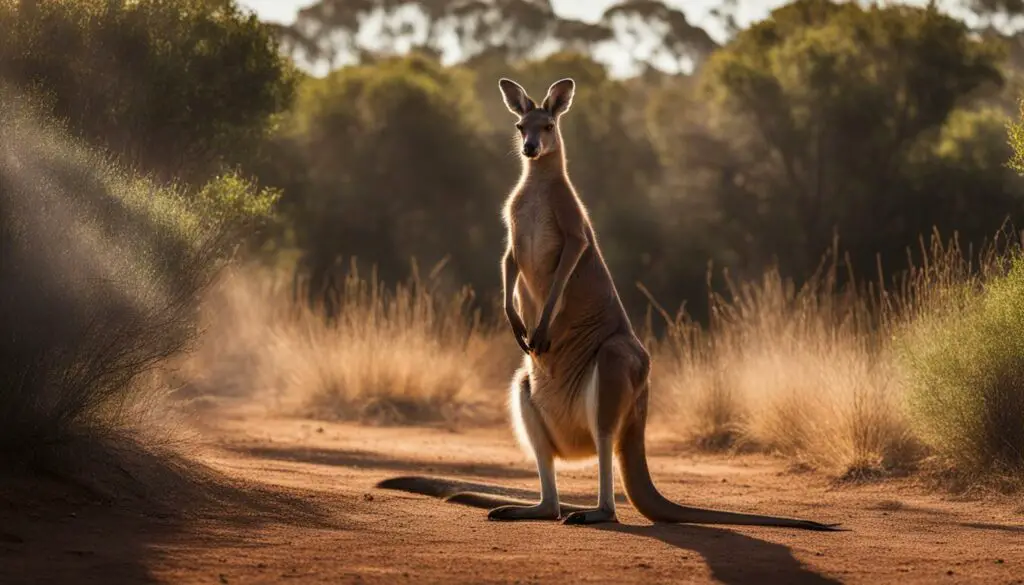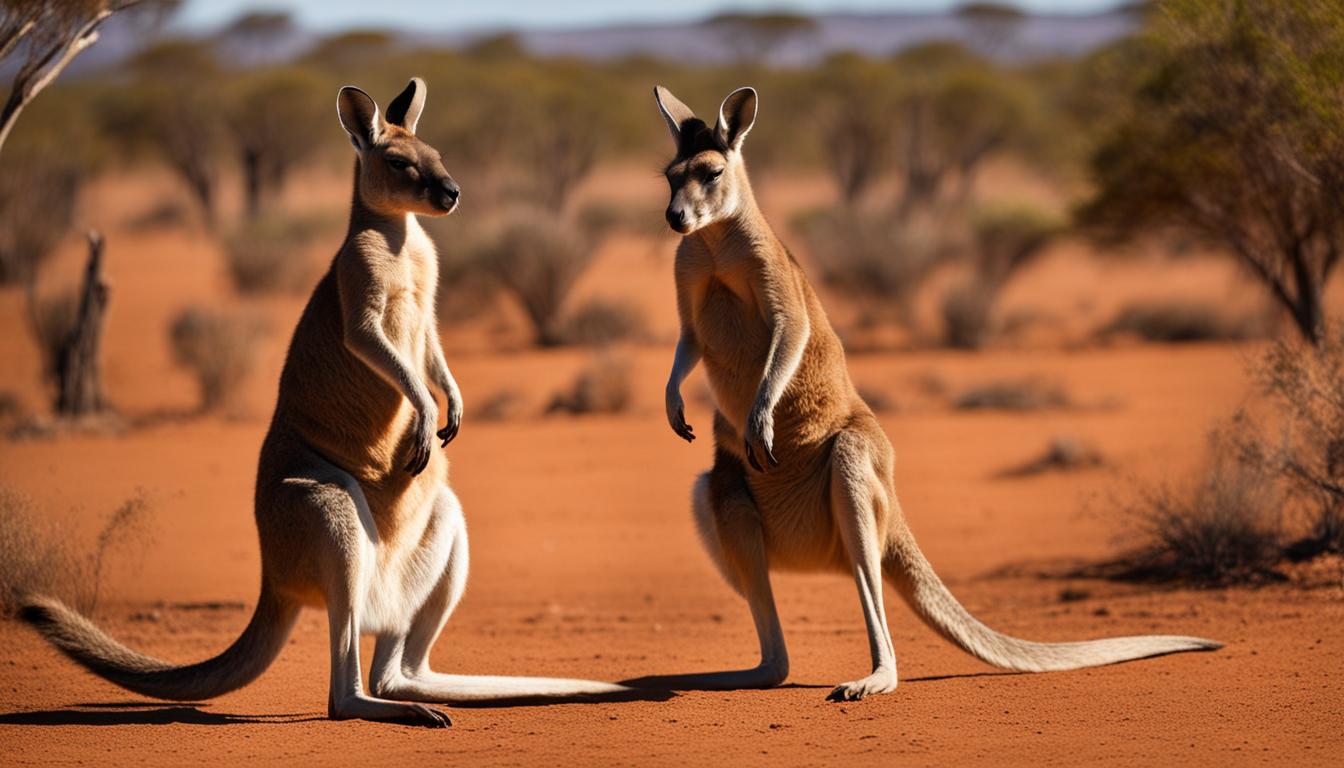Welcome to our article on the fascinating behavior of kangaroos! In this first section, we will explore how kangaroos use boxing as a form of social interaction. From their fighting techniques to their aggressive behavior, we’ll uncover the intriguing world of kangaroo combat.
When it comes to social interaction, kangaroos have a unique approach. Boxing plays a crucial role, especially during the mating season. Male kangaroos engage in fierce battles to establish dominance and gain access to females. They showcase their strength through biting, kicking, and yes, boxing.
Kangaroos possess agile arms and can spar vigorously using their forepaws. They use their powerful hind feet to defend themselves against predators, and in some cases, can even disembowel dogs and humans. It’s an astounding display of their strength and survival instincts.
While boxing is an important behavior for kangaroos, allowing them to establish their social hierarchy and protect themselves in the wild, it’s not the only aspect of their fascinating lives. In the upcoming sections, we will delve deeper into the social structure, group dynamics, and the reality of kangaroo boxing behavior in the wild.
The social structure of kangaroos
Kangaroos have a unique social structure that revolves around loose groupings called “mobs.” These mobs consist of several individuals, and their compositions can change over time. Within each mob, there is a dominant male known as the “old man” or “boomer” who leads the group, especially during the mating season. The dominance of the male kangaroo is established through various aggressive behaviors, including biting, kicking, and boxing.
Size and age play crucial roles in determining dominance within the kangaroo mob. Typically, larger and older males tend to be more dominant, while younger and smaller males may have lower social status. The female kangaroos and their young form the core of the mob, and their association with the dominant male ensures their protection and access to resources.
Alongside dominance displays, kangaroos also exhibit territorial behavior. They mark their territories and defend them against intruders. This territorial behavior helps maintain the social structure and ensures that resources are available for the mob. Kangaroo combat, including physical altercations, mainly occurs during the mating season when males compete for access to females.
To get a closer look at the social structure of kangaroos, let’s delve into a table illustrating the dynamics of a kangaroo mob:
| Kangaroo Social Structure | Description |
|---|---|
| Mob | A group of kangaroos |
| Old Man/Boomer | Dominant male leader of the mob |
| Mature Males | Associates of the dominant male |
| Female Kangaroos | Core members of the mob, including young and juveniles |
| Size and Age | Critical factors in determining dominance |
| Kangaroo Combat | Aggressive behaviors used to establish dominance during mating season |
| Territorial Behavior | Marking and defending territories against intruders |
Understanding the social structure of kangaroos provides valuable insights into their behavior and how they interact within their habitat. It highlights the importance of dominance displays, combat, and territoriality in shaping their relationships and maintaining order within the mob.
Kangaroo group dynamics
Kangaroos exhibit complex group dynamics, with the fundamental units of their social structure being “groups” and “subgroups.” These groups are partially open, with individuals moving in and out, creating a dynamic social environment. The average group size is around three individuals, but larger aggregations can form around resources like food, water, and shade.
During non-breeding seasons, kangaroos segregate based on sex, with males and females typically not interacting. Male kangaroos may seek out the company of other males, forming loose associations. These interactions among males provide opportunities for sizing up rivals and practicing fighting through sparring and aggressive interactions. Such sparring allows kangaroos to establish hierarchies and may play a role in preparing for mating season.
Understanding kangaroo group dynamics is essential for comprehending their social behavior and the factors that shape their interactions. It provides insights into how individuals navigate their social environment and establish social hierarchies, contributing to the overall understanding of kangaroo behavior.
Group Dynamics in Kangaroos
The reality of kangaroo boxing behavior in the wild
Contrary to popular belief, kangaroo boxing behavior is not a common sight in the wild. While kangaroos do engage in aggressive interactions, their fighting techniques involve a combination of biting, kicking, and grappling rather than boxing with their front paws. This misconception has been perpetuated through media and entertainment portrayals, leading to a misunderstanding of these fascinating creatures.
Kangaroos primarily use aggressive displays such as chest thumping, tail thumping, and vocalizations to establish dominance, defend their territories, and attract mates. These behaviors are part of their natural instinct and play a crucial role in the social dynamics of kangaroo communities. However, boxing with their front paws is not a prominent behavior observed in the wild.
“Kangaroos have evolved unique physical adaptations and behaviors to navigate their environments and interact with one another. While boxing may make for entertaining portrayals in popular culture, it does not accurately reflect the reality of kangaroo behavior in their natural habitats.”
It’s important to note that kangaroos are generally non-aggressive towards humans unless provoked or feel threatened. They prefer to maintain a safe distance and avoid confrontations whenever possible. Understanding the true nature of kangaroo behavior is crucial for their conservation and protection in the wild.

The Reality vs. Myth: Kangaroo aggressive display
One of the common misconceptions surrounding kangaroos is their reputation for boxing. While it may be entertaining to imagine kangaroos exchanging blows with their front paws, the reality is quite different. Kangaroos rely on a range of other aggressive displays and behaviors to establish their dominance and navigate social interactions.
Kangaroos use chest thumping, tail thumping, vocalizations, and other physical gestures to communicate their intentions and assert their dominance. These displays, along with territorial marking, help kangaroos establish and maintain their social hierarchy within their communities.
While boxing may capture our imagination, it is important to remember that the true beauty and complexity of kangaroo behavior lies in their unique set of evolutionary adaptations and social dynamics. By understanding and appreciating their true behaviors, we can better protect and conserve these iconic Australian creatures for generations to come.
The historical exploitation of boxing kangaroos
Kangaroos have unfortunately been subjected to a dark history of exploitation for human entertainment. In the 19th and early 20th centuries, kangaroo fights were organized for public amusement. These fights involved pitting kangaroos against each other or other animals, such as dogs. However, it is crucial to note that boxing kangaroos, as often depicted in media and entertainment, are not a common behavior observed in the wild. Real kangaroo fights involved a combination of biting, kicking, and grappling rather than the boxing with front paws that is often portrayed. These fights often resulted in injuries or death for the animals involved, raising ethical concerns about their exploitation.
Apart from fights, kangaroos were also trained to perform tricks and mimic human boxing in circus performances. This further exploited their natural behavior for the amusement of human audiences. It is important to recognize that these practices go against the well-being and natural behavior of these animals. Kangaroos are wild creatures that should not be forced into performing actions that are not part of their natural repertoire. The historical exploitation of boxing kangaroos highlights the need for ethical treatment and protection of wildlife.
“Real kangaroo fights involved a combination of biting, kicking, and grappling rather than the boxing with front paws that is often portrayed.”
Efforts have been made to raise awareness about the exploitative history of boxing kangaroos and to advocate for the ethical treatment of these animals. Organizations and individuals are working towards protecting kangaroos in the wild and ensuring their well-being. Conservation efforts aim to preserve their natural habitats, implement sustainable practices, and educate the public about the importance of respecting wildlife. By supporting these initiatives and promoting responsible and conscious interactions with animals, we can help protect kangaroos and ensure their continued existence in the wild.
| Year | Event | Impact |
|---|---|---|
| 1836 | First recorded kangaroo fight in Australia | Popularized the exploitative entertainment |
| 1870s | Kangaroo fights in the United States | Expanded the exploitation to a global scale |
| Early 20th century | Kangaroos trained to box in circus performances | Further exploited kangaroos for human entertainment |
Protecting kangaroos in the wild
Kangaroos, like many other wildlife species, are facing numerous threats in their natural habitats. To ensure the survival of these iconic Australian creatures and maintain the biodiversity of the ecosystems they inhabit, various conservation efforts are being undertaken.
One key aspect of kangaroo conservation is the creation of protected areas. These designated zones provide safe havens for kangaroos to live, breed, and thrive without disturbance from human activities. By preserving their habitats, we can safeguard the natural balance and ecological integrity of these areas.
In addition to protected areas, sustainable hunting practices are being implemented to protect kangaroo populations. By regulating hunting activities and setting quotas, authorities can ensure that the harvesting of kangaroos is done in a responsible and controlled manner. This approach helps to maintain healthy population numbers while also supporting the livelihoods of local communities that depend on kangaroo meat and products.
Raising awareness is crucial in the efforts to protect kangaroos. By educating the public about the importance of conservation and the need to preserve kangaroo populations, we can foster a sense of responsibility and encourage individuals to take action. Increased awareness can lead to changes in behavior and attitudes, ultimately benefiting kangaroos and their habitats.
Protecting kangaroos for a sustainable future
Kangaroo conservation is vital for the long-term survival of these unique and fascinating creatures. Through the establishment of protected areas, sustainable hunting practices, and the promotion of awareness, we can ensure that kangaroos continue to play their important role in the Australian ecosystem.
By protecting kangaroos in the wild, we not only preserve a national symbol of Australia but also contribute to the overall health and resilience of our natural environment. Together, let us work towards a sustainable future where kangaroos thrive in their natural habitats for generations to come.
What Role Does Boxing Play in Kangaroo Social Interactions?
In understanding fascinating kangaroo behavior explained, we can see that boxing plays a crucial role in their social interactions. This behavior is often seen during disputes over food, mates, or territory. Boxing helps establish dominance and maintain the social hierarchy within a kangaroo community.
FAQ
How do kangaroos use boxing in social interactions?
Kangaroos use boxing as a form of social interaction, particularly during the mating season. Male kangaroos fight each other for dominance and access to females. They use biting, kicking, and boxing to establish their dominance. Kangaroos also use boxing as a means of self-defense against predators. They have agile arms and can spar vigorously using their forepaws. In some cases, kangaroos can even disembowel dogs and humans with their hind feet. Boxing is an important behavior for kangaroos, allowing them to establish their social hierarchy and protect themselves in the wild.
What is the social structure of kangaroos?
Kangaroos have a loose and structured social structure. They live in groups, known as “mobs,” with shifting compositions. The largest male, known as the “old man” or “boomer,” dominates the group during the mating season. Male kangaroos fight for access to females using various aggressive behaviors, including biting, kicking, and boxing. Dominance within the group is determined by size and age, with larger and older males typically being more dominant. Female kangaroos with young and juveniles form the core of the groups. Associations among mature males are loose and not long-lasting. Kangaroos also exhibit territorial behavior, marking their territories and defending them against intruders.
What are the dynamics of kangaroo groups?
Kangaroos have complex group hierarchies. The fundamental units of social structure in a kangaroo population are “groups” and “subgroups.” Membership in these groups is partially open, with individuals moving in and out of groups. The average group size is about 3 individuals, but larger aggregations can form around food, water, and shade. During non-breeding seasons, there is sexual segregation, with males and females not interacting. Male kangaroos may seek out the company of other males, resulting in male-female segregation. These interactions among males may provide opportunities for sizing up rivals and practicing fighting through sparring and aggressive interactions.
Is boxing behavior common among kangaroos in the wild?
While boxing kangaroos may be a popular myth perpetuated in media and entertainment, it is not a common behavior observed in the wild. Kangaroos do fight, especially during the mating season, but they use a combination of biting, kicking, and grappling rather than boxing with their front paws. The aggressive displays seen in kangaroos include chest thumping, tail thumping, and vocalizations. These behaviors are used to establish dominance, defend territories, and attract mates. Kangaroos are generally non-aggressive towards humans unless provoked or feel threatened.
What is the history of the exploitation of boxing kangaroos?
Boxing kangaroos have a dark history of exploitation for human entertainment. In the 19th and early 20th centuries, kangaroo fights were organized for public amusement, where kangaroos were pitted against each other or other animals like dogs. These fights often resulted in injuries or death for the animals involved. Kangaroos were also trained to perform tricks and box like humans in circus performances. This exploitation of kangaroos for entertainment purposes raises ethical concerns and goes against the natural behavior and well-being of these animals.
How can kangaroos be protected in the wild?
Kangaroos are facing various threats in the wild, including habitat loss, climate change, and hunting. Several conservation efforts are being undertaken to protect kangaroos and their habitats. This includes creating protected areas, implementing sustainable hunting practices, and raising awareness about the importance of preserving kangaroo populations. It is crucial to protect kangaroos in their natural habitat to ensure their survival and maintain the biodiversity of Australia’s ecosystems.











